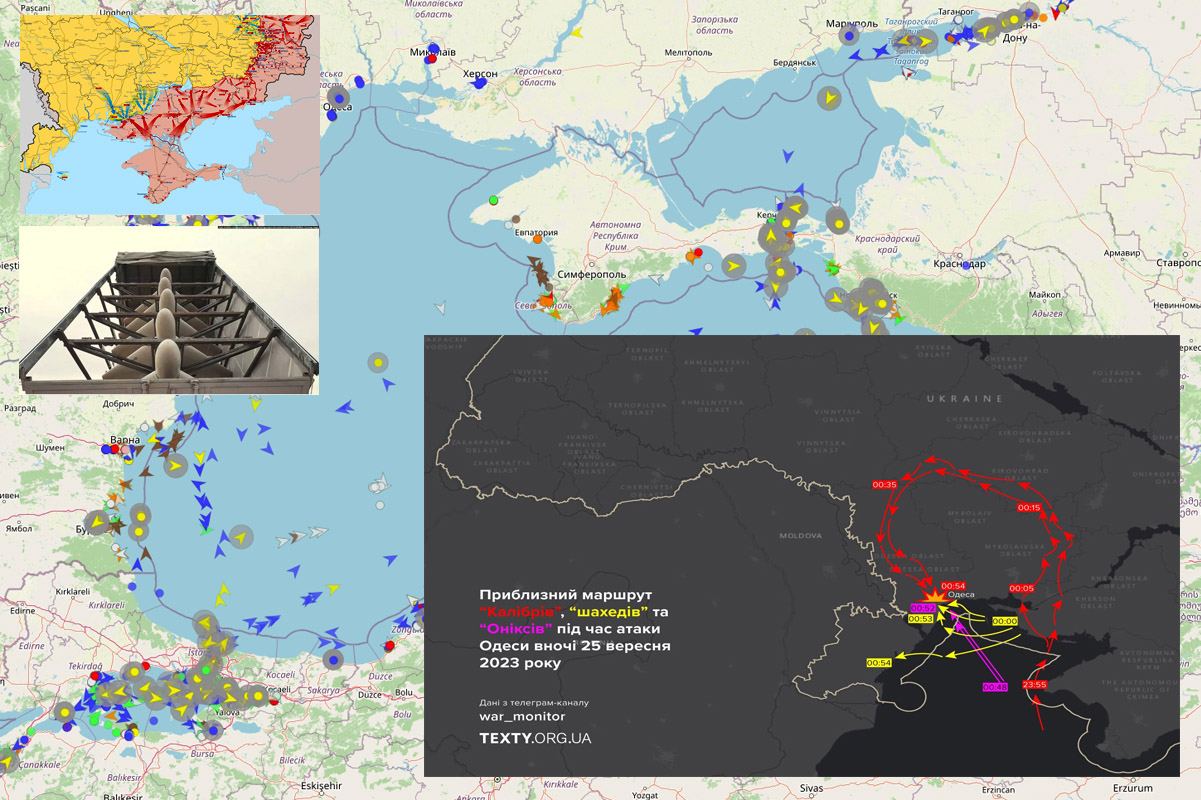Russia's use of the territory of occupied Crimea for aggression against Ukraine and creating a threat to the countries of the region in 2023

The Monitoring Group of the Black Sea Institute of Strategic Studies
and BlackSeaNews
The Monitoring Group of the Black Sea Institute of Strategic Studies and BlackSeaNews, based on the results of its own monitoring of Russian missile and unmanned aerial vehicle (UAV) attacks on the regions of Ukraine from the territory of occupied Crimea in January-September 2023, publishes an analytical report and forecasts about further use by Russia of the occupied peninsula’s territory for aggression against Ukraine and creating a threat to the countries of the region in 2023.
We hope that our experts’ opinions, conclusions, and forecasts will clearly demonstrate to politicians, diplomats, analysts, and journalists in countries supporting Ukraine's struggle against the Russian invasion that without the liberation of Crimea, it is impossible to talk about victory in this war.
* * *
Prior to February 24, 2022, the plans of Russian military-political leadership envisaged widespread use of the temporarily occupied territory (TOT) of Crimea as a springboard for offensive operations, a logistics hub for the ground forces support, and the aviation and naval groups base for striking the entire depth of Ukraine’s territory.
Given the extensive layered air defense system, the protection system of the bases and command and control points, the favorable operational environment on the administrative border with the southern regions of Ukraine, and the combat potential of the Armed Forces of Ukraine (AFU) at the time, the measures undertaken seemed quite sufficient to Russia’s General Staff.
Among other things, the use of the Crimea territory and infrastructure in the interests of the so-called SVO, included:
-
use of the existing civilian/military airfield infrastructure for the south troops air support;
-
ensuring reliable basing, i.e., repair, restoration, replenishment of logistics, etc., of the ship and boat fleet of the Black Sea Fleet (BSF) of Russia's Southern Military District (SMD) and the FSB Border Service;
-
use of military training grounds for coordinating the newly created units and restoring combat capability of those that needed it;
-
use of Crimea’s extensive road and rail transportation network for material support of frontline troops and establishing rapid connections with the freshly annexed «Russian regions»;
-
use of a powerful secure military logistical support system that had been significantly improved since the illegal 2014 annexation of Crimea;
-
launching missile and bomb strikes from the ARC using surface-to-surface missile systems, such as the operational and tactical Iskander and Bal and Bastion coastal missile systems;
-
assisting the Russian SMD BSF in conducting a naval landing operation in the southern districts of the Odesa and Mykolaiv regions.
However, the unsuccessful for Russia’s military machine 2022 course of events forced its leadership to significantly revise its plans regarding the use of the Crimean peninsula.
The activity of the Ukrainian defense forces, including in the southern theater, the liberation of parts of the Kherson and Mykolaiv regions, the city of Kherson itself and Zmiinyi Island, and the establishment of Ukrainian control over maritime communications in Ukraine's exclusive economic zone off the coast of the Odesa region forced the Russians to turn to the tried and true doctrine of the famous English World War II Air Marshal Arthur Harris, who significantly reduced Germany's military-industrial potential via the so-called «carpet bombing.»
But given that the Russians had not been preparing and, therefore, were not technologically ready for a protracted war, they turned to Iran for help in purchasing UAVs, subsequently used mainly to attack Ukraine’s energy facilities.
After the appointment of General Sergei Surovikin, first as the Southern Grouping’s commander in June 2022, and then, as commander of the Joint Forces Group in Ukraine in October 2022, Russia began implementing a significantly modified plan of utilizing the occupied Crimea's potential, in which the role of the Black Sea Fleet was reduced to just guarding its bases with only sporadic strikes against Ukraine.
Meanwhile, Ukraine’s defense forces quickly adapted and learned to counter the BSF Kalibr sea-launched cruise missile attacks, especially since Russia experienced a significant shortage of those from mid-2022 through mid-2023.
In the first 9 months of 2022, Russia used 391 Kalibr sea-launched cruise missiles, including by the Caspian Flotilla and the Black Sea Fleet, or up to 43 missiles per month, to strike at Ukrainian territory.
However, the ensuing 2023 missile shortage had forced Russians to significantly reduce their use, while compensating for those with Shahed-136/131 UAVs.
Thus, between January-May 2023, Russians used 93 Kalibr-type missiles, i.e., up to 18 missiles monthly, and 37 Shahed-136/131 drones in up to 7 drone attacks monthly, against Ukraine from Crimea.
Such relatively small number of the drone strikes launched from Crimea — Cape Chauda in the peninsula’s southeast, to be exact — most likely, indicates both the unpreparedness of the infrastructure and a certain drone shortage.
It should be also noted that the use of other types of missiles, after being quite intense in the first half of 2022, later dwindled: over the first 5 months of 2023, the Russians used only a few Onyx anti-ship missiles, a couple of dozen Iskander ballistic/cruise missiles, and the same number of aircraft missiles of various types.
All that changed in the second half of 2023, when Ukraine's defense forces significantly increased their firepower against the Russian forces in occupied Crimea, striking at the peninsula's naval warehouses, air defense facilities, logistics depots, airfields, and enemy command posts.
As the Crimean peninsula had ceased to be the «unsinkable aircraft carrier» for the Russian troops, the invaders were forced to move almost the entire aviation group, most of the missile carrying ships and submarines and critical defense facilities to the Krasnodar Krai, which has significantly diminished their firepower effectiveness against the Ukrainian forces.
That, together with such factors as insufficient protection of Ukraine's port and agricultural infrastructure, increased supply and possibly even pre-serial production of military drones in Russia itself, the cost effectiveness of destroying Ukrainian grain export facilities, and the prepared and protected Shahed launch infrastructure and personnel, had most likely led to the Russian decision to significantly increase the use of drone strikes against targets in Ukraine.
Thus, from June to September 2023, Russians launched 553 Shahed-136/131 drones from Cape Chauda, or 110 per month, demonstrating a whopping 15-fold increase, while the use of Kalibr sea-launched cruise missiles over the same period has increased only from 93 to 137. The use of other types of missiles remains unchanged.
Conclusions:
This report was not intended as merely a calculation of the number of attack/reconnaissance drone launches from the Crimean peninsula or the usage of the Crimean waters by the Russian Coastal Missile Forces fleet/units in missile strikes on Ukraine’s civilian and military infrastructure.
The objective, rather, was to analyze the logic of the Russian grouping command regarding its military capabilities in Crimea, and attempt to predict possible future developments.
Based on the above, in the next 5-7 months, we should expect:
-
Further rise in the use of the Crimean aviation/military infrastructure capabilities for launching strike/reconnaissance drones:
taking into consideration the existing trends of a significant increase in the number of the Shahed-136/131 drone attacks, and according to the Ukrainian Air Force Command, improvement of their tactical and technical characteristics, beginning of the serial UAV production in Russia and development of the system of training drone operators in Russia’s AF training centers.
-
Depending on the development of the Ukrainian counter-offensive, further growth of the share of strike drone launches from Crimea,...
...due to a more favorable cost-effectiveness ratio compared to sea-based cruise missiles, operational and tactical complexes of the Coastal Missile Forces and aviation missiles that require ground carriers or the use of strategic/tactical aviation.
-
Use of operational and tactical missile systems, i.e., Iskander, sea-based cruise missiles of the Kalibr type and coastal missile systems of the Bastion and Bal type, that hasn’t shown any tendency for increase, only for strikes on priority targets:
control points a.k.a. «decision-making centers,» ammunition depots and Ukraine’s critical civilian infrastructure, or in massive strikes with the combined full range of drones and missile weapons to ensure guaranteed target destruction. It is likely that the Russian Armed Forces continue to accumulate missile resources to provide fire support for its activities in certain areas.
-
Use of the ship and boat fleet and aviation group in Crimea, along with missile strikes against Ukraine, mainly for reconnaissance in the northwestern and southwestern parts of the Black Sea:
protection of maritime communications and airspace around the Crimean peninsula, escorting «the Syrian Express» supply vessels and monitoring the intelligence activities of NATO member states and the grain corridor.
-
Provocations by warships/supply vessels of the Russian BSF against commercial vessels involved in the transportation of Ukrainian grain can’t be excluded.
-
In addition, it’s possible that under the pretext of mine danger coming from Ukraine, Russian BSF submarines or civilian vessels will create mine-hazardous zones along the grain corridor sections.
-
In case Russia manages to reach agreements with the third countries, such as Iran or N. Korea, regarding the supply of weapons — primarily missiles — the Russian naval grouping will increasingly and happily distance itself from conducting combat operations in the areas within reach of the Ukrainian fire.
-
Continued Russia’s gross violation of international maritime law and deliberate obstruction of civilian navigation by distorting the satellite navigation signal with the use of the radio-electronic equipment located in the southwestern and western Crimea.
It is important to realize, however, that despite the heavy losses suffered by the Russian military grouping in occupied Crimea, it still remains quite powerful and capable of significantly influencing the situation in the northwestern and western Black Sea.
At the same time, Russia's military potential that it had before the start of large-scale aggression in February 2022 has already been lost, possibly forever. So let's hope for the best.
* * *
 This article has been prepared with the support of the European Union in Ukraine. The content of the article is the sole responsibility of the authors and does not necessarily reflect the position of the EU
This article has been prepared with the support of the European Union in Ukraine. The content of the article is the sole responsibility of the authors and does not necessarily reflect the position of the EU
More on the topic
- 07.11.2023 A database of attacks by Ukrainian drones and missiles on the territory of occupied Crimea and Russian ships in the Black Sea in January-October 2023
- 27.09.2023 The fate of the ships that were in the ports of Ukraine on 24 February 2022: The updated database
- 28.09.2022 As of September 26, 2022, 60 of 100 vessels remain blocked in the ports of Ukraine/ Database
- 31.07.2022 Blocked ships in Ukrainian ports during the war: The commercial sea port of Chornomorsk
- 27.07.2022 Blocked ships in Ukrainian ports during the war: The Odesa commercial sea port
- 24.06.2022 Blocked ships in Ukrainian ports during the war: The port of Kherson
- 11.05.2022 Blocked ships in Ukrainian ports during the war: the Pivdenny commercial sea port
- 10.04.2022 Ships blocked in Ukrainian ports during the war: The ports of the Mykolaiv region